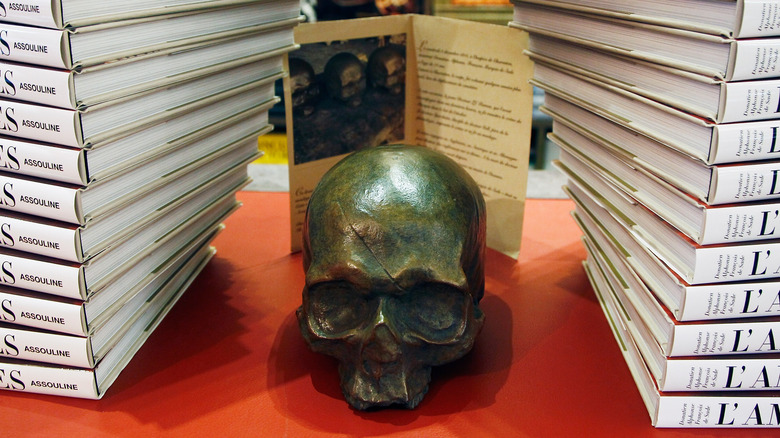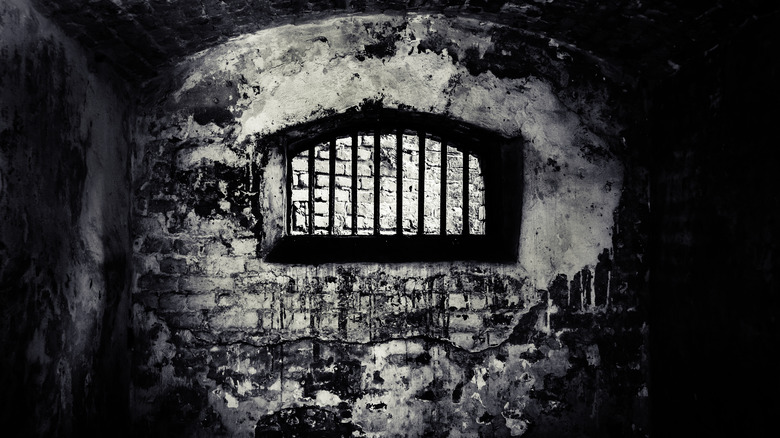Was Marquis De Sade Really So Sadistic?
For cinema fans of a certain sadomasochistic bend, there's no end to the graphic torture, rape, necrophilia, cannibalism, and outright vileness portrayed in films that generally don't make it to the local theater. Many folks would raise their fists and decry all such "art" — however we define that word — to be unnecessary, depraved, repulsive. Others might say it reveals necessary-to-confront truths about humanity.
In some ways, it's easy to see how we got here: the Enlightenment, the rise of secular humanism, broadening liberties of personal expression, an ever-increasing sense of ethical relativism, and so on (via the British Library). We live in history's most pluralistic time. Society and government struggle, incessantly, with questions about squaring fundamental, shared human ethics with a greater mono-culture that enshrines the sovereignty of the individual. So "free speech" is good? How about the "free speech" of the neo-Nazi? Individual ethics are good? How about the ethics of the libertine?
All such discussions are embodied in the life and work of French writer Donatien Alphonse François, aka Marquis de Sade (1740-1814). Sade, from whom we get our modern word "sadism," wrote some of the most shocking, horrific works in history, and spent most of his life reviled and imprisoned (via The Conversation).
He wrote 120 Days of Sodom
It might be hard for a 21st-century dweller to imagine that a 1785 novel ranks as the most horrifically graphic and disturbing book of all time. But for those willing to crack it open, Marquis de Sade's "120 Days of Sodom" truly lives up to its reputation. In its most extreme sections, "120 Days of Sodom" is appalling to the point of inducing nausea. We're talking about seemingly endless combinations of torture and sex and tons of other details better suited to a "Human Centipede" meets "Saw" franchise mash-up.
As The Conversation discusses, the book is framed as a series of escapades between four libertines — a duke, a bishop, a judge, and a banker. In their attempts to one-up each other and push the limits of human sensation, the libertines' debaucheries escalate to the point of carnage and nigh-slaughterhouse bloodletting.
In many ways, Sade's work presaged our modern era of grindhouse films, dark web depravities, and an endless public appetite for detail upon dramatized detail of the most twisted serial killer's crimes. After all, have people actually been any different? And yet, in an era about 250 years ago, long before The Sun could post a ludicrously huge "Top 80 True Crime" list of Netflix shows, how much more shocking would Sade's work have been to the public?
Imprisoned, shunned, and hunted
Those approaching Marquis de Sade generously could look at a work like "120 Days of Sodom" and say, "Oh, he's critiquing the human obsession with sensation and decadence, and saying that it leads to a self-destructive end. I get it." But actually, they'd be wrong. Sade wasn't eviscerating (figuratively) human nature or French society. He actively engaged in what he wrote about, as The Conversation discusses. Over his life, he was tossed in jail for rape, torturing a 36-year-old beggar, imprisoning six children in his home, poisoning sex workers, and more. Sade was hated, hunted, escaped attempts on his life, and lived on the run as an outlaw.
While in prison, Sade didn't exactly help his case. It was within the compression of incarceration that Sade penned not only "120 Days of Sodom," but most of his other work, including "Justine, or the Misfortunes of Virtue" (1791) and "Philosophy in the Bedroom" (1795). Each work displays Sade's brazen libertarianism and describes the same kind clandestine, bloodied orgies. In turn, his writings — aside from the man and his actual life — were decried as the "abominable" off-shoot of a "depraved imagination" by no less than Napoleon Bonaparte himself.
Sade spent over half his life in prison, including his final 11 years in an asylum under the diagnosis of "libertine dementia" without hearing, trial, or public debate, as The New York Times describes in a review of a Sade biography. Simply put, society didn't know what to do with him.
Raised in a family of libertines
Same as the critiques directed towards Marquis de Sade, the Marquis himself was a by-product of his upbringing. Via The New York Times review of the Maurice Lever biography "Sade," the Marquis from came an old, noble, wealthy family. His father was a luxury-obsessed libertine who trotted from bedroom to bedroom and ruined both his family's fortune and reputation. His mother was practically non-existent from the time her son was 4 years old. Sade's uncle raised him in a castle full of the types of cellars and underground chambers that populated all of Sade's novels. This uncle, who was a member of the clergy, was a libertine himself who owned a substantial library of work that went on to inspire Sade's life and writings.
At age 10, Sade was sent off to a Jesuit school in Paris, where his natural inclinations took on sharper definition. Whipping was the primary punishment for serious offenses at school, including homosexual activity between students; so began the pleasure-pain cycle that Sade sought his entire life. Add to this the belief that flagellation was a "noble punishment," and we can see how Sade came to equate suffering with rewards.
By the age of 19, Sade's disposition and behaviors were more than solidified. His arranged marriage almost fell through because of the severity of his venereal disease, and he had already been arrested numerous times by the time he hired an unemployed cotton spinner to let him cut and whip her in a secret chamber in his Paris home.
Philosopher, liberator, and free speech icon?
Marquis de Sade first came to the attention of the English-speaking world in 1954, when doctoral student Austryn Wainhouse translated the Marquis' writings from French. Thus marked the beginning of a battle of censorship that wound up with Sade being hated by some, lauded by others, and his work piggybacking into prominence on all things countercultural in the 1960s, as The Conversation explains.
People like the French poet Guillaume Apollinaire (1880-1918) called Sade "the freest man that ever was," via The New York Times review. In her essay "The Sadeian Woman," posted on the website of the British Library, English writer Angela Carter (1940-1992) described Sade as a philosopher first, a liberator of sexuality whose writing reflects the "corruption of force and power within a repressive society." He was an artistic "moral pornographer" who "might use pornography as a critique of the current relation between the sexes." The Philosophy similarly describes Sade as a "free thinker" who advocated for "moral subversions."
Maurice Lever, who released his Sade biography in 1993, describes Sade as a precursor to Sigmund Freud. De Sade exposed the connection between sex and aggression, says Lever, and "made us discover that the sexual instinct is anarchic and uncontrollable." Lever also prefigured our very sadistic, modern true crime obsession, saying that Sade "writes about the instinct that makes us watch live footage of a man kill his wife on television, and derive some pleasure from it."
Fifty Shades of Sodom
Defenders of Sade, then, often cast him in one of several roles: postmodern hero of the vocal minority, subversive and luminary artist, comical reprobate dashing away from a midnight rendezvous, or purveyor of "unleash your true self" sexual wisdom a la "Fifty Shades of Grey." Or as Alice LaBorde, professor of French literature at UC Irvine, puts it, Sade was "a family man, a loving husband and a loving father" (via the Los Angeles Times). Such defenders will castigate opponents of Sade as morally prudish Puritans, while opponents of Sade will characterize him and his sympathizers as twisted perverts.
All such discussions miss one key fact, though. Sade didn't merely write about torture, kidnapping, and the rest in flights of fancy. He was imprisoned for these actual crimes himself (via The Conversation). It's true that he was also imprisoned for the "crime" of sodomy (gay sex), but that doesn't negate actions like imprisoning children.
To himself, Sade's philosophy is perhaps best summarized in his rhetorical statement, "Were it among Nature's intentions that man be born modest, she would not have caused him to be born naked" (per The Conversation). Sade believed it was a mark of authenticity — at least the lack of a denial of reality — to engage in behaviors often considered depraved. But the question begs: No matter how undeniably necessary it is to acknowledge one's true self, would our social, cooperative species have even survived if everyone behaved with Sade-like impulsiveness?





